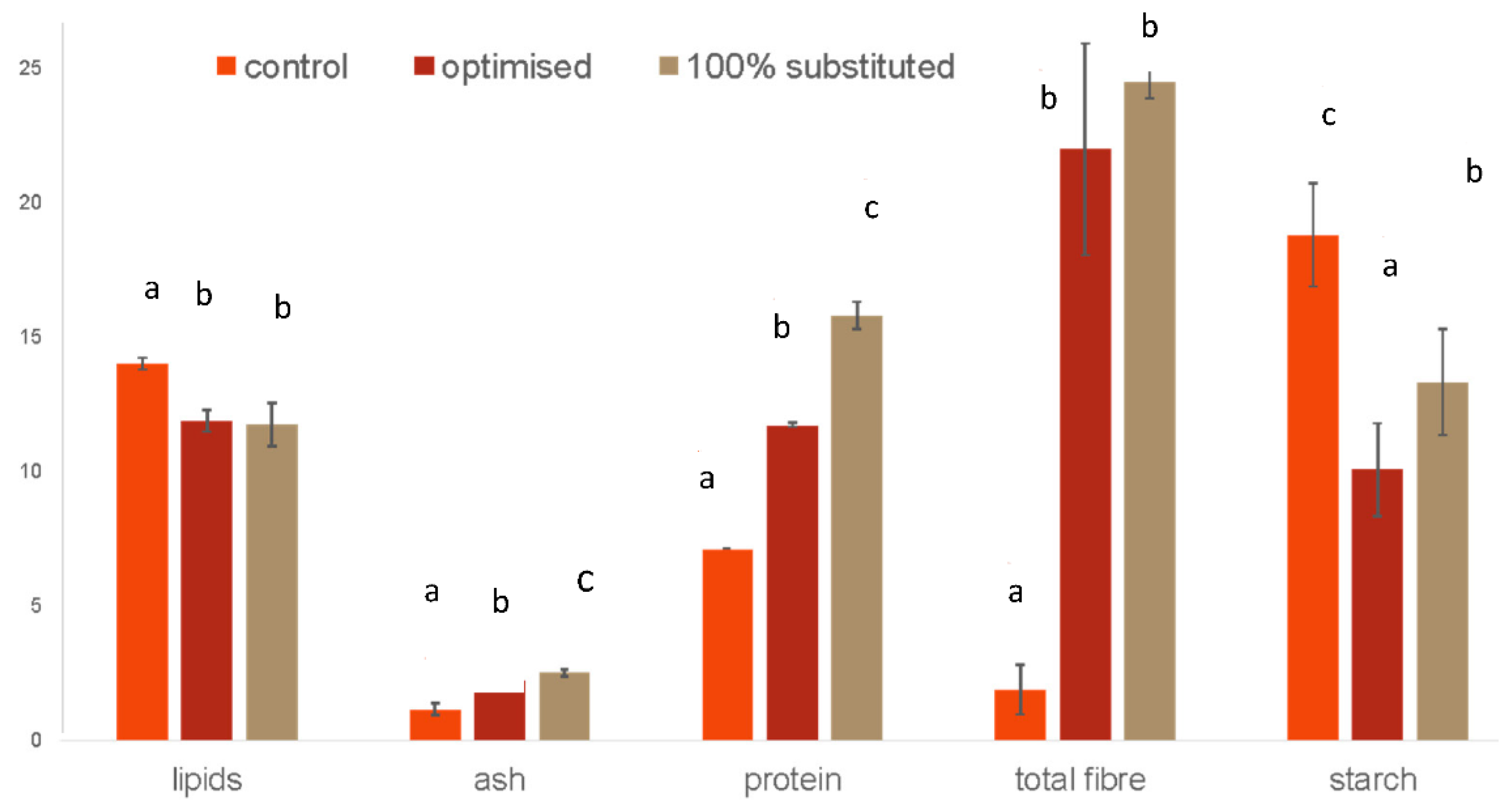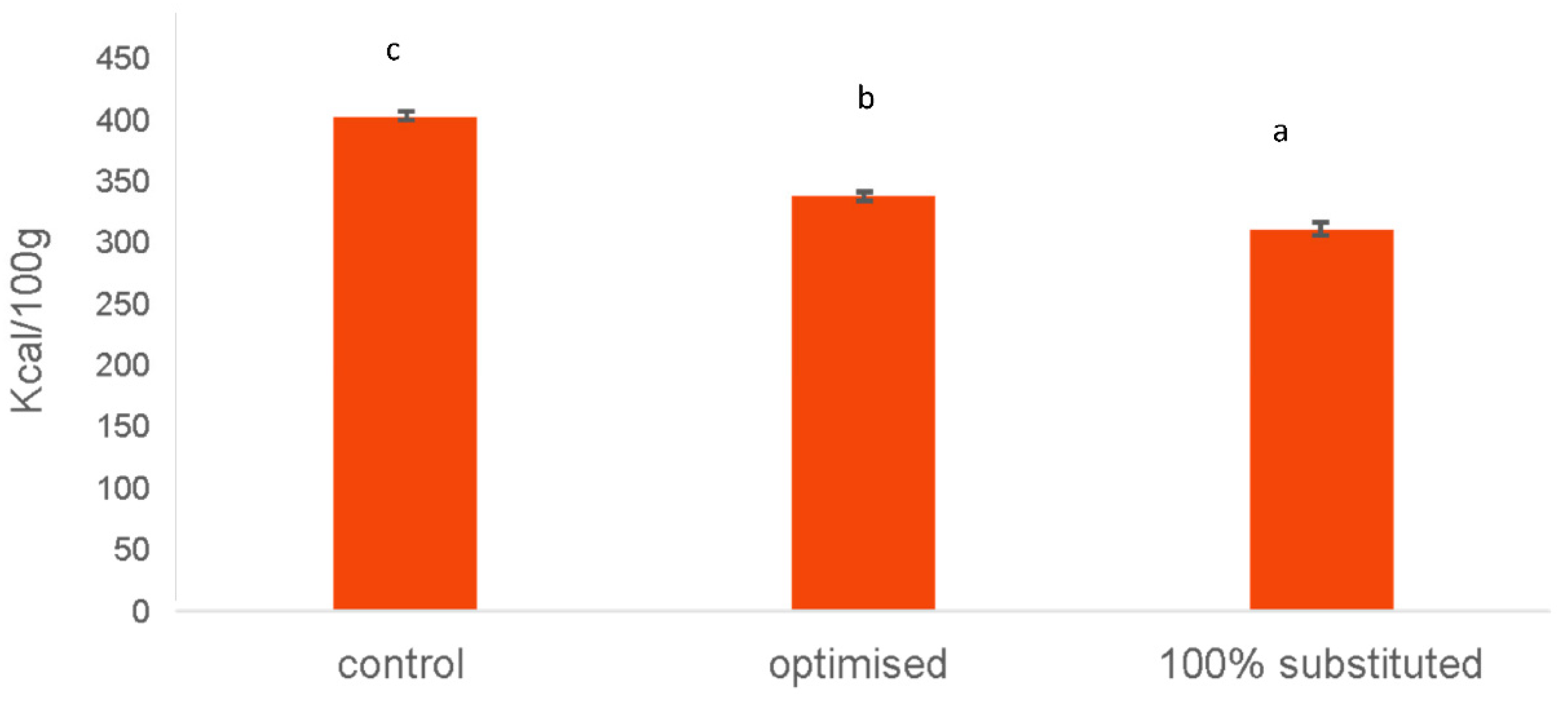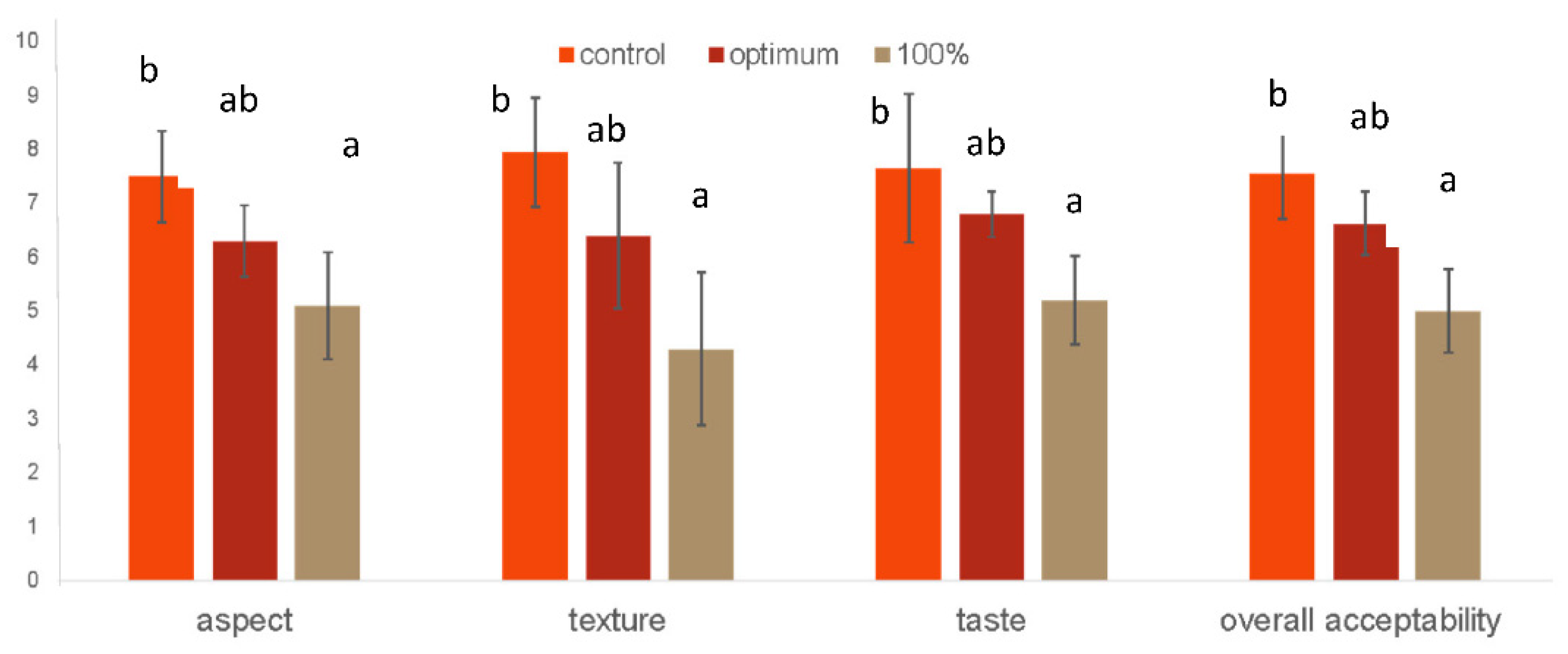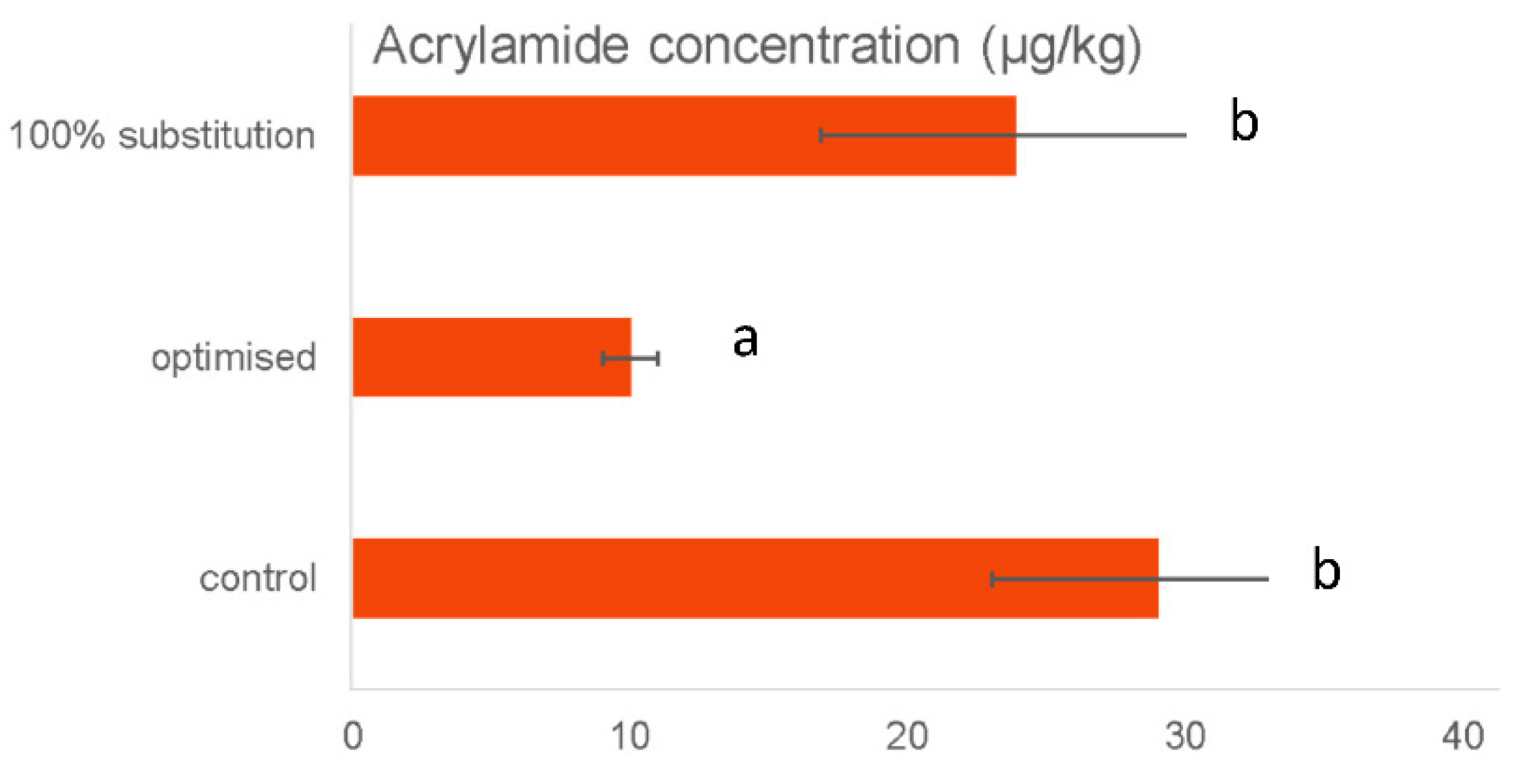1. Introduction
Nowadays, the relationship between nutrition and health has become a trend in constant evolution because consumers are aware of the importance of their diet, so they consume foods that are low in fat, salt, and/or calories and high in nutritional value.
Baked products are an important part of one’s diet, and today, a great variety of such products can be found by adding innovative ingredients to improve their nutritional characteristics [
1]. In particular, cookies are frequently eaten by all segments of the population [
2].
Quinoa (
Chenopodium quinoa) and chia (
Salvia hispanica L.) are ingredients that stand out for their high nutritional value, containing essential fatty acids (omega-3 and omega-6), high mineral and vitamin content [
3], high amounts of fibre [
1], and high biological-value proteins and essential amino acids [
4]. Therefore, adding these ingredients to the formulation of cookies will nutritionally improve their properties.
As cereal products are a source of acrylamide, and as many studies have indicated its carcinogen potential, its concentration in the cookie products was investigated. The International Agency of Research on Cancer has classified acrylamide as a probable human carcinogen (Group 2A).
This study aimed to investigate the utility of chia and quinoa products as ingredients to produce cookies with high nutritional value and to evaluate their technological and sensorial quality.
2. Materials and Methods
2.1. Materials
The raw materials were commercial flour, whole royal quinoa flour (Chenopodium quinoa Willd), and fibre chia fraction (Salvia hispanica L.) from BENEXIA Company (Santiago, Chile). Commercial butter, sunflower oil, chia oil, and nonfat dry milk were purchased from local market (Valencia, Spain).
2.2. Cookie Production
The cookie control dough formula was made according to the Approved American Association of Cereal Chemists (AACC) method 10-52 [
5]. The cookie formulations with quinoa, chia fibre, and/or chia/sunflower oil were obtained by replacement flour, sugar, and butter, respectively, at three levels (0, 50, and 100% substitution following a factorial design 3
3 (
Table 1).
2.3. Baking Conditions
The conditions for making the cookies were optimized (170–180 °C and 11 min) and were used to elaborate the control, optimized, and 100% substituted formulations.
2.4. Proximate Composition of the Cookies
Analyses of the cookies were completed to determine the total dietary fibre (TDF) and starch according to the approved AOAC Methods 991.43 and 996.11, respectively [
6]. Protein determination was performed with the Dumas combustion method and a nitrogen conversion factor of 6.25 (ISO/TS 16634-2) [
7], whereas the lipids and ash contents were determined according to the AACC Methods 30-10 and 08-03 [
8], respectively.
2.5. Preliminary Sensory Evaluation
The preliminary sensory evaluation was carried out by 20 untrained testers who consume cookies in their everyday life. The parameters that were evaluated were: aspect, texture, taste, and overall acceptability on a 9-point hedonic scale (9) “Especially like”; (8) “Very much like”; (7) “Moderately like”; (6) “Somewhat like”; (5) “Neither like nor dislike”; (4) “Slightly dislike”; (3) “Moderately dislike”; (2) “Very much dislike”; and (1) “Especially dislike” [
9].
2.6. Determination of Acrylamide
The UNE-EN 16618:2015 method was implemented to determine acrylamide concentration in the cookie samples (Eurofins Ecosur Laboratory, Murcia, Spain).
2.7. Statistical Analysis
To establish significant differences between samples (p < 0.05), one-way ANOVA and Fisher’s least significant differences (LSD) were applied.
3. Results
The optimal formulation, taking into account technological and nutritional parameters, was observed at around 60% substitution of wheat flour for whole quinoa flour, around 80% substitution of butter for chia-sunflower oil mix, and around 50% substitution of sugar for chia fibre fraction with stevia.
To corroborate that the optimal cookie formulation had a better nutritional value than the control, a comparison between samples was completed. The substitution with whole quinoa flour or chia fibre increased the mineral content; the substituted sample at 100% had the highest values, followed by the optimized sample and the control sample. The results are shown in
Figure 1. Protein values and total dietary fibre values showed the same pattern as for ashes. The results obtained were due to quinoa having a high content of total minerals (ash). The caloric values of the three samples are represented in
Figure 2, where the control formulation has the highest value, followed by the optimized sample, and the 100% substituted formulation showed the lowest value. These results were explained by the fact that the control sample has a significant quantity of simple carbohydrates and is poor in dietary fibre.
According to the preliminary sensory evaluation, all the studied parameters showed the same pattern: the high value corresponds to the control, followed by the optimized sample and the lowest values for the 100% substituted cookie (
Figure 3). However, the samples are acceptable by consumers, with overall acceptability for the optimal formulation between 7 and 8 on the hedonic scale.
The International Agency of Research on Cancer [
10] has classified acrylamide as a possible human carcinogen (Group 2A). In
Figure 4, we can observe the values obtained for acrylamide in the three studied formulations. The results indicate that the highest acrylamide levels were found in the control samples, followed by the 100% substituted cookies, with the lowest value in the optimized sample. All the formulations presented lower values than the recommended limit of the EU Regulation 2017/2158, lower than 350 μg/kg for biscuits and wafers [
11].
4. Conclusions
The optimized sample is highly nutritious and has a similar technological quality to the control sample with lower harmful components, such as acrylamide, than the control. Therefore, the optimized cookie, with the replacement of critical ingredients, is a nutritional and healthy alternative to common cookies for a better diet.
Author Contributions
Conceptualization, C.M.H.; methodology, G.M. and S.A.; validation, G.M. and S.A.; formal analysis, G.M.; investigation, G.M., S.A. and C.M.H.; resources, C.M.H.; writing—original draft preparation, G.M.; writing—review and editing, C.M.H.; visualization, G.M. and C.M.H.; supervision, C.M.H.; project administration, C.M.H.; funding acquisition, C.M.H. All authors have read and agreed to the published version of the manuscript.
Funding
This work was supported by grant Ia ValSe-Food-CYTED (119RT0567) and Food4ImNut (PID2019-107650RB-C21) from the Ministry of Sciences and Innovation (MICINN-Spain).
Institutional Review Board Statement
Not applicable.
Informed Consent Statement
Not applicable.
Acknowledgments
Giorgos Myrisis’s fellowship from the Erasmus Program of the Agricultural University of Athens is acknowledged.
Conflicts of Interest
The authors declare no conflict of interest.
References
- Alcântara Brandão, N.; Borges de Lima Dutra, M.; Andrade Gaspardi, A.L.; Segura Campos, M.R. Chia (Salvia hispanica L.) Cookies: Physicochemical/Microbiological Attributes, Nutrimental Value and Sensory Analysis. Food Meas. 2019, 13, 1100–1110. [Google Scholar] [CrossRef]
- Brito, I.L.; de Souza, E.L.; Felex, S.S.S.; Madruga, M.S.; Yamashita, F.; Magnani, M. Nutritional and Sensory Characteristics of Gluten-Free Quinoa (Chenopodium Quinoa Willd)-Based Cookies Development Using an Experimental Mixture Design. J. Food Sci. Technol. 2015, 52, 5866–5873. [Google Scholar] [CrossRef] [PubMed] [Green Version]
- Coelho, M.; Salas-Mellado, M. Chemical characterization of chia (Salvia hispanica L.) for cse in food products. J. Food Nutr. Res. 2014, 2, 263–269. [Google Scholar] [CrossRef] [Green Version]
- Miranda-Ramos, K.; Millán-Linares, M.C.; Haros, C.M. Effect of Chia as Breadmaking Ingredient on Nutritional Quality, Mineral Availability, and Glycemic Index of Bread. Foods 2020, 9, 663. [Google Scholar] [CrossRef] [PubMed]
- AACC. Baking Quality of Cookie Flour–Micro Method 10-52, 9th ed.; The American Association of Cereal Chemists: St. Paul, MN, USA, 1995. [Google Scholar]
- AOAC. Method 925.09, 991.43, 996.11, 986.11. In Official Methods of Analysis, 15th ed.; Association of Official Analytical Chemists: Arlington, VA, USA, 1996. [Google Scholar]
- ISO/TS. Food Products—Determination of the Total Nitrogen Content by Combustion According to the Dumas Principle and Calculation of the Crude Protein Content—Part 1 and 2: Cereals, Pulses and Milled Cereal Products, ISO/TS 16634-1 and ISO/TS 16634-2; International Organization for Standardization (ISO): Geneva, Switzerland, 2016. [Google Scholar]
- AACC. Approved Methods of AACC: Method 08-03, 30-10, 9th ed.; The American Association of Cereal Chemists: St. Paul, MN, USA, 2000. [Google Scholar]
- Iglesias-Puig, E.; Monedero, V.; Haros, M. Bread with Whole Quinoa Flour and Bifidobacterial Phytases Increases Dietary Mineral Intake and Bioavailability. LWT-Food Sci. Technol. 2015, 60, 71–77. [Google Scholar] [CrossRef]
- International Agency for Research on Cancer. IARC Monographs on the Identification of Carcinogenic Hazards to Humans; World Health Organization: Geneva, Switzerland, 2019. [Google Scholar]
- Commission Regulation (EU) 2017/2158. Establishing mitigation measures and benchmark levels for the reduction of the presence as acrylamide in food. J. Eur. Union 2017, 60, 24–44. [Google Scholar]
| Publisher’s Note: MDPI stays neutral with regard to jurisdictional claims in published maps and institutional affiliations. |
© 2022 by the authors. Licensee MDPI, Basel, Switzerland. This article is an open access article distributed under the terms and conditions of the Creative Commons Attribution (CC BY) license (https://creativecommons.org/licenses/by/4.0/).









